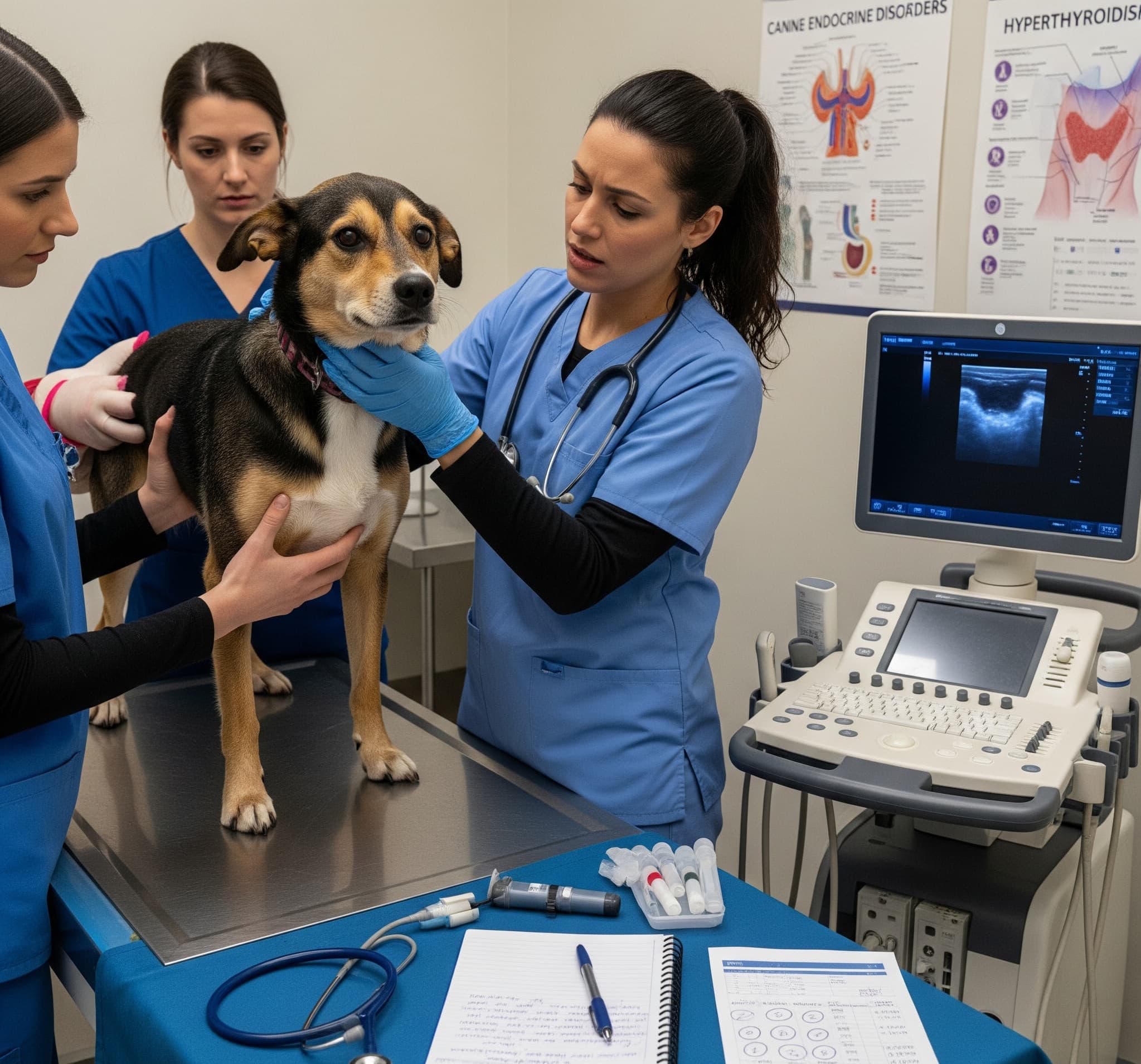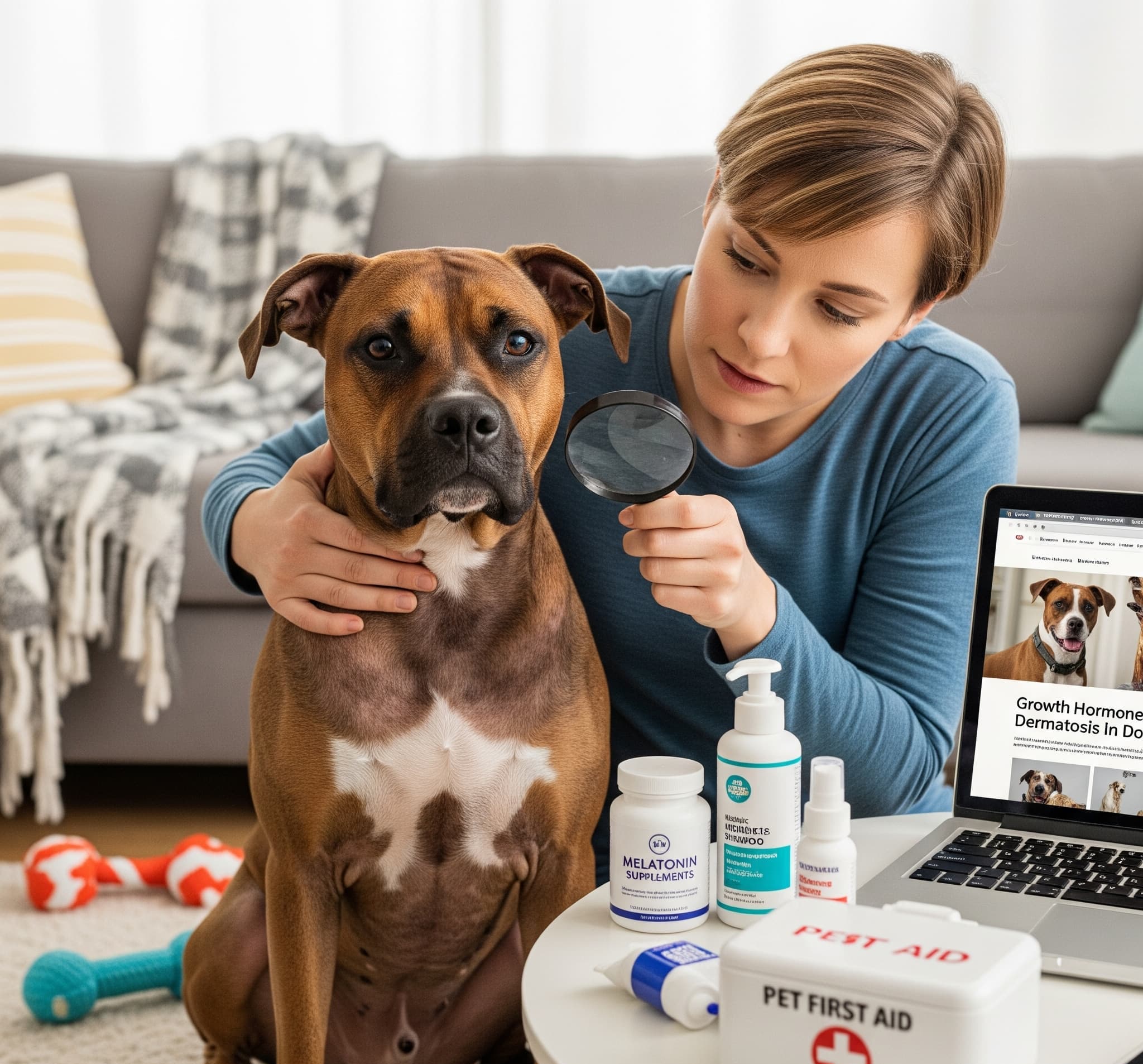Vets, Don’t Miss This: Solving the Puzzle of Rare Canine Hyperthyroidism
Meta Description: Explore diagnostic hurdles in unusual canine hyperthyroidism cases. Acquire expert strategies and diagnostic tools for practicing veterinarians. Discover more!
Introduce
As a veterinarian, you’re no stranger to thyroid disorders in dogs, yet rare hyperthyroidism cases can strike you as a perplexing riddle. Whereas hypothyroidism presents predictable signs, hyperthyroidism in canines slips under the radar, often masquerading as vague, cross-over symptoms you could attribute to several other ailments. This article focuses specifically on the diagnostic roadblocks you might encounter with this unusual condition, providing you with actionable techniques and expert insights to solve the mystery. Regardless of your years in practice, mastering these subtleties can decisively influence the outcome for your furry patients.
To help you make the most of this guide, here’s the roadmap we’ll follow:
- Why Is Canine Hyperthyroidism So Rare and Tricky?
- Key Symptoms to Watch for in Suspected Cases
- Diagnostic Tools: From Blood Tests to Scintigraphy
- Common Pitfalls and How to Avoid Misdiagnosis
- FAQs: Answering Your Top Questions on Canine Hyperthyroidism
Let’s get started and unravel this veterinary puzzle one piece at a time!
Why Is Canine Hyperthyroidism So Rare and Tricky?
Canine hyperthyroidism feels like spot-the-difference at a carnival—small differences, huge implications. In cats, the problem practically headlines every conference, yet in dogs it’s a whisper. When it shows up, it usually rolls in on the back of malignant thyroid carcinomas, leaving benign nodules in the dust. The uncommon nature lulls us into a diagnostic rut, because the signs—weight loss, increased appetite—could easily be the headline for Cushing’s, chronic kidney disease, or a dozen other, more talked-about conditions.
The difficulty lies in the fact that dogs can behave unexpectedly. You might be waiting for the textbook signs—thinness combined with a bottomless bowl—but instead the picture is broader: a dawdling gait, periodic panting, a three-ounce drop in weight, none of it exclusive to thyroid trouble. Given that the thyroid drives every calorie burned, even a fractional acceleration can tilt the scales, yet baseline blood panels might still pass. Practically, this keeps the practitioner mentally nimble, inserting hyperthyroidism discreetly yet firmly into a swirling list of conceivable problems, particularly when the leading suspect is only a hunch.
Key Symptoms to Watch for in Suspected Cases
So, which little whispers should the alert clinician strain to hear? When the gland is under discussion, a handful of markers seem to wave a tiny flag.
Steady Loss with Steady Diet: Dog bolts food with puppy vigor, yet the scale shows downhill—pay close attention.
Polydipsia and Polyuria: Sudden, fresh, dramatic intake and frequent, firm puddles; both signal, but diabetics and renal patients can too.
Pacing and Accelerated Respiration: The pup that can’t quit moving, or that pants in the lobby when the AC is on full; the body is trying to cool a hidden blaze.
Neck Exam Aids: A firm, asymmetrical enlargement just anterior to the trachea; in some, it will be present, in many it will not, but it is a physical touchstone.
Heart Tells: A persistent, elevated pulse or breaks in rhythm during auscultation; the body is wiring itself for excess and giving the heart the overtime bill.
The signs we see with this condition aren’t exclusive to an overactive thyroid, so it’s an easy diagnosis to misread. Take a thyroid tumor in a dog: you might see coughing or trouble swallowing, which feels respiratory but is actually a red flag for thyroid trouble. Keeping hyperthyroidism on the differential list—especially in senior dogs and certain breeds like Boxers and Goldens—will help you stay sharp and not overlook it.
Diagnostic Tools: From Blood Tests to Ultrasound
So, how do we nail the diagnosis? You need a toolbox because no one test seals the deal on hyperthyroidism in dogs. Here’s the playbook:
- Serum Thyroid Hormone Levels: Always start with total T4 and free T4. High values raise the eyebrow, but normal ranges don’t clear you—tumors can spike and drop variably.
- TSH Levels: A suppressed thyroid-stimulating hormone reading backs a hyperthyroidism diagnosis. Just make sure you’re using a canine-specific assay to get it right.
- Thyroid Ultrasound: This non-invasive technique lets you peer into the thyroid for masses or subtle changes. Think of it as an X-ray for what we can’t normally see, and it’s vital to limit surprises once the diagnosis is on the table.
Scintigraphy: This test remains the benchmark for confirming an overactive thyroid in dogs. By using small amounts of radioactive tracers, it reveals how the thyroid is actually functioning at the cellular level. The downside is straightforward: it’s not routinely available in every practice, which means an outside referral is often necessary.
Biopsy or Fine-Needle Aspiration: If a suspicious thyroid enlargement is palpated, this procedure is invaluable for differentiating between a benign adenoma and a malignant carcinoma. The distinction alters the treatment and prognosis significantly, so don’t skip it when there’s a lump.
Pro tip: Always link hormone tests with imaging studies. For instance, a pup with a normal total T4 and a convincing thyroid mass still warrants scintigraphy; it could expose unsuspected hyperfunction within the gland that the broad T4 missed. Like assembling a jigsaw, every datum is a piece, and the final picture only forms when all are in hand.
Common Pitfalls and How to Avoid Misdiagnosis
Ah, that sinking feeling when a confident diagnosis unravels. Misreading canine hyperthyroidism is a rookie’s error precisely because it masquerades so well; the signs are innocent cousins to a dozen other disorders. Here’s how to dodge the top traps:
Blurring with Cushing’s Disease: Excessive drinking, labored breathing, and fluctuating weight are same-same in both. Defuse the overlap with a prompt ACTH stimulation test.
Neglecting Thyroid Tumors: A hyperthyroid picture can exist without a visible mass, but missing that lump can push the treatment start date from urgent to optional. A thorough neck palpation must become a non-negotiable part of every physical exam.
Don’t Rely on T4 Alone: Usually normal T4 doesn’t rule out hyperthyroidism. Pair it with free T4 and imaging to nail down the diagnosis.
Miss the Breed Angle: Breeds like Beagles and Boxers are genetically prone to thyroid tumors. Keep this on the differential list, even if the numbers are small.
Forget the Follow-up: Thyroid levels can move. If the first set is shaky and the dog still acts unwell, circle back and retest.
Simple Fix: Jot down a checklist for any dog that raises a flag. It’s a low-tech, high-value tool that adds rigor and catches the outlier signs.
FAQs: Answering Your Top Questions on Canine Hyperthyroidism
How does it compare in dogs and cats?
Hyperthyroidism is a dog rarity—about 1 in 1,000—while it hits cats around 1 in 10 in the older set. Dogs get it mostly from carcinomas, cats from adenomas. That gap keeps us on our toes when a hyper dog walks through the door.
Can blood tests give a firm answer?
They can’t always get there solo. High T4 and low TSH suggest trouble, but normal numbers leave the door open. That’s when imaging—usually ultrasound or scintigraphy—brings clarity. Think of it as needing both a map and a compass to find the good stuff.
The outlook hinges on the lesion type. Non-malignant adenomas usually respond well to medical management or lobectomy, while thyroid carcinomas often show rapid spread. Catching the disease early gives us our best chance, so a tissue-based test at the first suspicion is crucial.
Final Thoughts
Proving canine hyperthyroidism is a diagnostic riddle, but armed with the right tactics, you can solve it. Watch for subtle signs like poor coat, mild tachycardia, or the owner mentioning a spike in appetite, then follow up with a free T4, quantitative scan, and possibly cytology. Sidestep diagnostic traps by keeping a disciplined workup, cross-referencing Breed Club predispositions, and always thinking about concurrent disease. Each case is a chance to put the science in service of a healthier dog and a calmer owner.
Want more exclusive tips? Post your knottiest thyroid case in the comments, and subscribe to our newsletter for high-value veterinary content straight to your practice inbox!




Post Comment